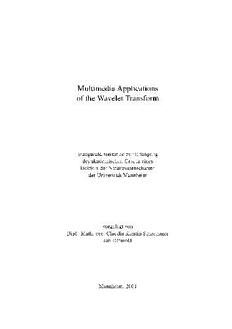Table Of ContentMultimedia Applications
of the Wavelet Transform
Inauguraldissertation zur Erlangung
des akademischen Grades eines
Doktors der Naturwissenschaften
der Universita¨t Mannheim
vorgelegt von
Dipl.–Math. oec. Claudia Kerstin Schremmer
aus Detmold
Mannheim, 2001
Dekan: Professor Dr.HerbertPopp,Universita¨tMannheim
Referent: Professor Dr.WolfgangEffelsberg, Universita¨tMannheim
Korreferent: Professor Dr.GabrieleSteidl,Universita¨tMannheim
Tagdermu¨ndlichen Pru¨fung: 08.Februar2002
Ifweknewwhatweweredoing,
itwouldnotbecalledresearch, wouldit?
—AlbertEinstein
Abstract
Thisdissertationinvestigatesnovelapplicationsofthewavelettransformintheanalysisandcompres-
sion of audio, still images, and video. In a second focal point, we evaluate the didactic potential of
multimedia–enhanced teachingmaterialforhighereducation.
Most recently, some theoretical surveys have been published on the potential for a wavelet–based
restoration of noisy audio signals. Based on these, we have developed a wavelet–based denoising
program foraudiosignals thatallowsflexibleparameter settings. Itissuited forthedemonstration of
thepotential ofwavelet–based denoising algorithms aswellasforuseinteaching.
The multiscale property of the wavelet transform can successfully be exploited for the detection of
semantic structures in still images. Forexample, a comparison of the coefficients in the transformed
domain allows the analysis and extraction of a predominant structure. This idea forms the basis of
our semiautomatic edge detection algorithm that was developed during the present work. A number
of empirical evaluations of potential parameter settings for the convolution–based wavelet transform
andtheresulting recommendations follow.
In the context of the teleteaching project Virtuelle Hochschule Oberrhein, i.e., Virtual University of
theUpperRhineValley(VIROR),whichaimstoestablishasemi–virtualuniversity,manylecturesand
seminarsweretransmitted betweenremotelocations. Wethusencountered theproblem ofscalability
of a video stream for different access bandwidths in the Internet. A substantial contribution of this
dissertation istheintroduction ofthewavelettransformintohierarchical videocodingandtherecom-
mendation of parameter settings based on empirical surveys. Furthermore, a prototype implementa-
tionofahierarchical client–server video program provestheprincipal feasibility ofawavelet–based,
nearlyarbitrarily scalable application.
Mathematical transformations of digital signals constitute a commonly underestimated problem for
students in their first semesters of study. Motivated by the VIROR project, we spent a considerable
amount of time and effort on the exploration of approaches to enhance mathematical topics with
multimedia;boththetechnicaldesignandthedidacticintegrationintothecurriculumarediscussed. In
alargefieldtrialontraditional teachingversusmultimedia–enhanced teaching,inwhichthestudents
were assigned to different learning settings, not only the motivation, but the objective knowledge
gained by the students wasmeasured. This allows us to objectively rate positive the efficiency of the
teaching modulesdevelopedinthescopeofthisdissertation.
II ABSTRACT
Kurzfassung
Die vorliegende Dissertation untersucht neue Einsatzmo¨glichkeiten der Wavelet–Transformation fu¨r
die Analyse und Kompression der multimedialen Anwendungen Audio, Standbild und Video. In
einem weiteren Schwerpunkt evaluieren wir das didaktische Potential multimedial angereicherten
Lehrmaterials fu¨rdieuniversita¨re Lehre.
In ju¨ngster Zeit sind einige theoretische Arbeiten u¨ber Wavelet–basierte Restaurationsverfahren von
verrauschten Audiosignalen vero¨ffentlicht worden. Hierauf aufbauend haben wir ein Wavelet–
basiertesEntrauschungsprogramm fu¨rAudiosignaleentwickelt. EserlaubteinesehrflexibleAuswahl
von Parametern, und eignet sich daher sowohl zur Demonstration der Ma¨chtigkeit Wavelet–basierter
Entrauschungsansa¨tze, alsauchzumEinsatzinderLehre.
Die Multiskaleneigenschaft der Wavelet–Transformation kann bei der Standbildanalyse erfolgreich
genutzt werden, um semantische Strukturen eines Bildes zu erkennen. So erlaubt ein Vergleich der
Koeffizienten im transformierten Raum die Analyse und Extraktion einer vorherrschenden Struk-
tur. Diese Idee liegt unserem im Zuge der vorliegenden Arbeit entstandenen halbautomatischen
Kantensegmentierungsalgorithmus zugrunde. Eine Reihe empirischer Evaluationen u¨ber mo¨gliche
Parametereinstellungen der Faltungs–basierten Wavelet–Transformation mit daraus resultierenden
Empfehlungen schließen sichan.
ImZusammenhangmitdemTeleteaching–Projekt VirtuelleHochschuleOberrhein(VIROR),dasden
Aufbaueinersemi–virtuellen Universita¨tverfolgt, werdenvieleVorlesungen undSeminarezwischen
entfernten Ortenu¨bertragen. DabeistießenwiraufdasProblemderSkalierbarkeit vonVideostro¨men
fu¨runterschiedlicheZugangsbandbreitenimInternet. EinwichtigerBeitragdieserDissertationist,die
Mo¨glichkeiten der Wavelet–Transformation fu¨r die hierarchische Videokodierung aufzuzeigen und
durch empirische Studien belegte Parameterempfehlungen auszusprechen. Eine prototypische Im-
plementierung einer hierarchischen Client–Server Videoanwendung beweist zudem die prinzipielle
Realisierbarkeit einerWavelet–basierten, fastbeliebigskalierbaren Anwendung.
Mathematische Transformationen digitaler Signale stellen fu¨r Studierende der Anfangssemester eine
ha¨ufig unterscha¨tzte Schwierigkeit dar. Angeregt durch das VIROR Projekt setzen wir uns in einem
weiterenTeildieserDissertation mitdenMo¨glichkeiten einermultimedialen Aufbereitung mathema-
tischerSachverhalteauseinander; sowohldietechnischeGestaltungalsaucheinedidaktische Integra-
tion in den Unterrichtsbetrieb werden ero¨rtert. In einem groß angelegten Feldversuch Traditionelle
LehreversusMultimedia–gestu¨tzteLehrewurdennichtnurdieMotivation,sondernauchderobjektive
Lernerfolg vonStudierenden gemessen, dieunterschiedlichen Lernszenarien zugeordnet waren. Dies
erlaubt eine objektive positive Bewertungder Effizienz derimRahmendieser Dissertation entstande-
nenLehrmodule.
IV KURZFASSUNG
A few words. . .
...ofacknowledgment usually areplaced atthislocation. AndIalso wishtoexpress mygratitude to
allthosewhocontributed totheformationofthisdissertation.
The presented work took shape during my employment as a research assistant in the teleteaching
projectVIRORandattheDepartmentPraktischeInformatikIV,whereProf.Dr.WolfgangEffelsberg
accepted meinto his research group on multimedia techniques and computer networks. In this team,
I encountered a delightful job surrounding where cooperation, commitment, and freedom of thought
were lived and breathed. Prof. Effelsberg not only was my intellectual mentor for this work, he also
actively used the teaching modules which were developed during my job title in his lectures. The
feedback of the students facilitated their steady improvement. By the way, Prof. Effelsberg was my
‘testsubject’forboththedigitalteachingvideoandthelecturewhichwasstackedupagainstitforthe
evaluation introduced in Part III of this work. I am heartily obliged to him for my initiation into the
worldofscience,fortipsandclueswhichhaveinfluencedthethemeofthiswork,andforhisunfailing
support. Prof.Dr.GabrieleSteidldeservesmanythanksforhaving overtakentheco–advising.
I am beholden to my colleagues Stefan Richter, Ju¨rgen Vogel, Martin Mauve, Nicolai Scheele, Jo¨rg
Widmer, Volker Hilt, Dirk Farin, and Christian Liebig, as well as to the ‘alumni’ Werner Geyer and
OliverSchusterfortheiroffersofhelpinthecontroversywithmyideas. Beitthroughprecisethematic
adviceanddiscussionsorthroughsmalljointprojectswhichledtocommoncontributionstoscientific
conferences. Mostnotably, Iwanttoshowmygratitude toChristoph Kuhmu¨nch, GeraldKu¨hne, and
Thomas Haenselmann, who exchanged many ideas with me in form and content and thus facilitated
theirfinaltranscription. ChristophKuhmu¨nchandGert–janLossacrificedashareoftheirweek–ends
tocross–readmymanuscript,tofindredundanciesandtodebugunclearpassages. Oursystemadmin-
istrator Walter Mu¨ller managed the almost flawlessly smooth functioning of the computer systems
and our more than unusual secretary Betty Haire Weyerer thoroughly and critically read through my
publications in the English language, including the present one, and corrected my ‘Genglish’, i.e.,
German–English expressions.
I particularly enjoyed the coaching of ‘Studienarbeiten’, i.e., students’ implementation work, and
diploma theses. Among them, I want to name my very first student, Corinna Dietrich, with whom I
grewatthetask;HolgerWons,SusanneKrabbe,andChristophEssersignedascontractstudentsatour
department after finishing their task — itseems that they had enjoyed it; Sonja Meyer, TimoMu¨ller,
AndreasPrassas,JuliaSchneider,andTillmannSchulzhelpedmetoexploredifferentaspectsofsignal
processing, even if not all of their work was related to the presented topic. I oweappreciation to my
diploma students Florian Bo¨mers, Uwe Bosecker, Holger Fu¨ßler, and Alexander Holzinger for their
thoroughexplorationofandworkonfacetsofthewavelettheorywhichfitwellintotheoverallpicture
VI A FEW WORDS...
ofthepresentedwork. Theyallcontributedtomydissertationwiththeirquestionsandencouragement,
withtheirimplementations andsuggestions.
Theproject VIRORpermitted metogetincontact withthedepartment Erziehungswissenschaft IIof
theUniversityofMannheim. Iappreciated thisinterdisciplinary cooperation especially onapersonal
level,anditmostprobablyisthisclimateonapersonal niveauwhichallowedustocooperate sowell
scientifically. Here I want to especially thank Holger Horz, and I wish him all the best for his own
dissertation project.
Insomeperiodsoftheformationprocessofthiswork,Ineededencouraging wordsmorethantechni-
calinput. Therefore, Iwanttoexpressmygratitude tomyparents, mysister, andmyfriendsfortheir
trustinmyabilitiesandtheirappealstomyself–assertiveness. Mymother,whoalwaysremindedme
thatthereismoretolifethanwork,andmyfather,whoexemplifiedhowtoquestionthecircumstances
and to believe that rules need not always be unchangeable. That the presented work was started, let
alone pushed through andcompleted, isduetoPeterKappelmann, whogivesmesomuch morethan
asimplelifecompanionship. Hemakesmylifecolorful andexciting. Thisworkisdedicated tohim.
ClaudiaSchremmer

